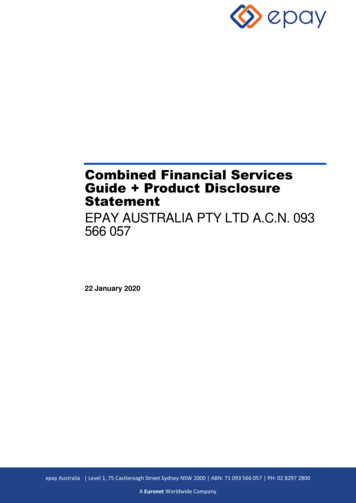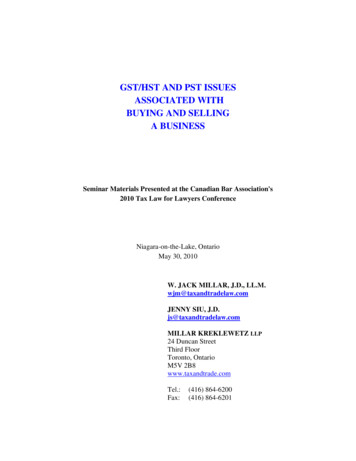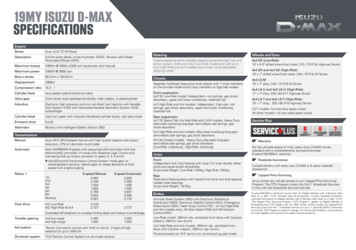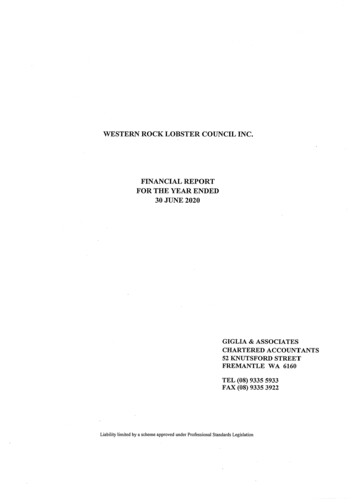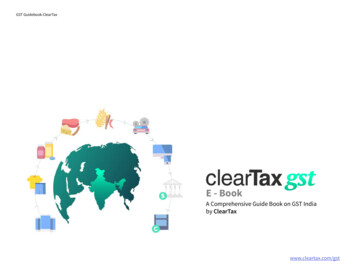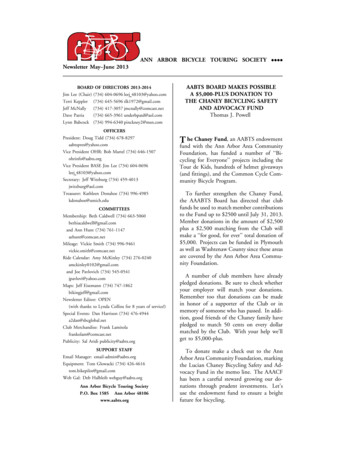
Transcription
2018 JETIR June 2018, Volume 5, Issue 6www.jetir.org (ISSN-2349-5162)CAN GST IN INDIA RIDE THE BLOCKCHAINREVOLUTION?Dr. Janki MistryDepartment of Business and Industrial Management, Veer Narmad South Gujarat University, Surat.ABSTRACT:-The much awaited Goods and Service Tax was introduced in India in 2017 under the BJP regime. It is indeedone of the most progressive financial system reforms to be introduced in the Indian economy. The law is made so as toincorporate and include all large and small Indian businesses in its purview. It is designed in such a way that businesses whichhad never ever paid taxes in history were all compelled to abide by the law. The government thereby managed to ruffle many anindustrial feather! The tax law according to experts is excellent in its drafting and aims for maximum benefit to businesses as wellas consumers, and at the same time, increasing the government revenues.However, the systems and infrastructure backing the implementation of the GST was fraught with many issues. Hence, thetransition from the older tax system to GST was not seamless. In fact, small and medium businesses were totally overwhelmedwith the compliance procedure which is byand large digital. This paper tries to identify and address the problems in the GSTsystem. This paper in theory, proposes a transition of the current system of GST network to Blockchain technology. Blockchain isa forward looking, highly sophisticated and secure distributed record keeping system which will help in the storage and analysisof large amount of taxpayer database which can be traced down to all past transactions. The system would include all the entitiesinvolved in the transaction and hence accord transparent and tamper free transactions. The model is based on consensus and henceall the transactions will have to be validated and approved of, by all the members of the group before the transaction. It is asystem based on trust and autonomy which will make the life of at taxpayer easy and the process of tax collection efficient. Thepaper explores the solutions that Blockchain can provide in dealing with the current problems of GST implementation.KEYWORDS:Block Chain, Goods and Services Tax, Validation, Smart Contracts, Electronic Ledger, Tax Evasion, InputTax Credit, Block, Hash, EncryptionINTRODUCTION:On July 1st, 2017, the Goods and Services Tax was rolled out in India. This rollout is considered to be the biggest indirect taxreform to have occurred in the Indian economy since after independence. Taxes such as Central Excise, Service Tax,Value AddedTax etc. are all types of indirect taxes. The onus of the tax payer is to simply collect this tax on behalf of the government and payit to the government. GST is about to change the way business is done in India(Poddar, 2017).Multiple indirect taxes which existed in India were eradicated and in its place one tax was implemented- the GST. This wasintended to make the life of a businessman easy. It also aimed to remove the complexities for foreign companies intending to dobusiness in India. It was aimed to be a major reform and positive move, but it seems that in India the whole implementationprocess was not well thought out and hence, the government is facing some amount of resistance on account of GSTimplementation. This paper aims to understand the technical and operational problems with respect to implementation (From thegovernment’s point of view) and compliance(from the business’ point of view) of GST. The solution to these problems lie indevising a more efficient and comprehensive system of tax collection which can only succeed with superior technology. The useof Block chain technology has been explored as a viable solution to the problems of GST.THE NATURE OF GST:GST is an indirect tax, which means that it is not levied directly to the income of individuals but added to the prices of goodsand services which inturn increase the Maximum Retail Price of the goods or services. This tax in the form of increased MRPisthen transferred by the companies/businessmen/traders to the central or state government. It is a comprehensive tax, theimplementation of which has lead to the abolition of 19 other indirect taxes which businessmen and traders had to pay earlier. It isa value added tax. Hence, tax is imposed on every value addition and so tax will be levied at the end of every sale. GST is adestination based tax rather than the origin based tax which existed earlier. It is imposed on the distribution of goods andservices(ClearTax, n.d.-a).GST in India is applicable in three ways, namely: SGST – the Good or Service Tax collected by State Government CGST – the Good or Service Tax collected by Central Government for an intra-state transaction IGST – the Good or Service Tax collected by Central Government for an inter-state transaction.Advantages of GST: Ease of compliance: It is expected that GST implementation will remove complex and multiple taxes and an efficientdigital system will back the processes to be followed. Uniform taxes: The tax rates will be same across the country and hence, there will be no confusion for intra statebusinesses. Differential pricing will be eliminated and consumers will benefit.JETIRC006087Journal of Emerging Technologies and Innovative Research (JETIR) www.jetir.org485
2018 JETIR June 2018, Volume 5, Issue 6www.jetir.org (ISSN-2349-5162) Cascading effect of taxes will be removed: Tax credits and payments will become seamless and hidden costs of doingbusiness would be removed. Reduction in costs: The costs of locally manufactured goods and services would go down and this would augur moresales. For governments: GST will increase tax collection in a simpler manner and compliance issues will be resolved as everybusinessman, small or big would be in the GST net. The cost of tax collection will decrease and hence it will lead to a moreefficient revenue collection. Digitisation of the whole process will lead to easy compliance. Overall tax burden of the consumer and businessman will reduce.So to put it in a nutshell, the GST was implemented for the greater good of Indian businesses and consumers. However, thingsdid not go according to plans. The government faced a lot of criticism and wrath from small and medium scale businesses afterGST was launched. The following were some of the points of contention: Amongst the Asian countries, the GST rates in India are the highest and there are four rates – 5%, 12%, 18% and 28%.This was heavily criticised by laypersons and experts. Businesses which have product or service categories falling in different rates are finding it difficult to make invoices. Compliance has to be done digitally and returns are to be filed every month. This is a big hindrance to those businesseswhich are not digitally savvy. Even those companies which were earlier filing service tax returns without a hitch feel the filing ofGST to be a tedious process. The whole process is online which adds to the problem(ClearTax, n.d.-b). Small businesses that have a small turnover and need not pay GST face trust issues. Buyers demand bills from eventhose sellers who are exempted from GST. Without proof of certificate of GST exemption, small shop owners find themselvesstranded and immobile. The E-Commerce businesses were also left in a lurch as they have to collect tax at source from the sellers. This hasdrastically affected their working capital. The GST council has fixed a rate of 1% TCS for E-Commerce companies. There were issues in the nationwide implementation of E way bills. Free movement of goods and services across thecountry is the main objective of GST. But the GST software to be unable to process mass requests to generate E way bills on dayone of implementation. This created a lot of mistrust amongst the business community. The purpose of E way bill is to avoid taxevasion and tracking of goods via RFID. Transit delays can be reduced because of reduced number of checking points for goodsin transport. It is also aimed at reducing paperwork as E way bills are to be generated digitally. It is also aimed at reducing India’scost to GDP ratio which is higher as compared to other Asian countries. However, E way bills have not been accepted smoothlyacross the country as very less time was available for understanding the intricacies of the E way bill and there was countrywideupheaval because of which the government had to roll back the system for three months in February when it was launched and relaunch it in June 2018. Another problem is that for consignments of less than value of Rs. 50000, an E way bill is not required.Many small scale traders are still taking advantage of this loophole(“Ewaybill - What is e-Way Bill? E way Bill Rules &Generation Process Explained,” n.d.). The initial process laid out by the Income tax authorities was full of glitches and hence the government had to change theapproach from a stringent one to a accommodating one wherein certain industries and businesses were given a leeway of filingreturns every three months instead of one month, a rollback on GST on certain items, exempting businesses under twenty lakhturnover from registration, cancellation of Eway bill etc. These actions seemed to dilute the effective implementation of the taxregime and people found more ways to evade ridicule and rebel against GST.So, even though the government implemented a forward looking progressive tax reform, the small and the medium scalebusinesses felt shortchanged and harassed. So the question that arises is, that what went wrong?In India, it seems that the problem is not about the tax itself, but in implementing it and the ability to comply with it. Anothermajor problem is the mentality of people to evade taxes.REVIEW OF LITERATURE:GST though being a progressive reform, faces many operational and compliance hurdles in India.The trasnsition from the original system to the new system is one of the major challenges that the businesses are facing. TheGSTN network which is termed as the backbone of the whole process has to be extremely robust and powerful. A huge amount ofdata will be collected and stored and the challenge is to process this huge database(Mittal, 2016).The businessmen and traders were not prepared for the implementation of GST in terms of their IT systems, supply chains andlegal matters. Nor were they prepared in terms of managing their working capital, fund flows and cash flows(ClearTax, n.d.-b).There was lack of clarity in the rules and regulations in terms of categorisation of goods, place of registration, E way billsgeneration and tracking of goods while in transit. It was not clear who would be spending towards the infrastructure required fortracking systems for trucks.There was a problem of increased compliance as more number of returns had to be filed. Every business would have to file aminimum of 37 GST returns in a year for proper compliance. If this is not done, they would lose out on the inputcredit(Saraswathy, 2017).Inadequacy of the IT systems was the biggest problem. The government needs to work vehemently towards adequate IT.Another problem was the confusion amongst the people within the Income tax department as regards with certain rules andregulations. There was lack of trained staff who could address the various questions and problems of the business communitynationwide. However, that in large part is being rectified by the government through various awareness camps andworkshops(Saraswathy, 2017).JETIRC006087Journal of Emerging Technologies and Innovative Research (JETIR) www.jetir.org486
2018 JETIR June 2018, Volume 5, Issue 6www.jetir.org (ISSN-2349-5162)There is a big dearth of skilled resources with the industries as well as the government who can effectively handle thecompliance and the implementation processes respectively.Besides this, many businessmen have found innovative ways to evade GST. In Delhi, the most common practice to evadeGST is ‘Bill to one and shift to another.’ This is a racket involving fake invoices which are generated in favour of parties whowant to take input credit, while those who do not need it, charge a premium(Siddhartha, 2018).One of the biggest practical issues that the small and medium business community is facing is the mismatch between GSTR1,GSTR2 and GSTR3. GSTR 1 is for supply of goods. So, when a businessman supplies goods and raises and invoice, it will berecorded in GSTR1. GSTR2 is for inward goods. When the goods are received, then that will be recorded in GSTR2. So, from thedetails of GSTR2, the government can check the details given in GSTR1 by the supplier. So in a nutshell, GSTR1 records thedetails of all sales and GSTR2 records the details of all purchases. Every month, the businessman has to file his return throughGSTR3 which will contain the monthly summary of sales and purchases and the tax liability. The problem which cropped up isthe mismatch between GSTR1 of suppliers and GSTR2 of buyers. In this case, the input tax credit to be disbursed would beincorrect. In case there is a mismatch, GSTR3 cannot be filed and hence, it will attract penalty and interest on the unpaid amountof tax. Besides, the next month’s GSTR1 cannot be prepared. This created a lot of ruckus and disgruntlements from the businesscommunity. As a stopgap arrangement, the government has revoked the filing of GSTR2. Hence, for the time being, the matchingbetween sales and purchases is inaccurate. Eventually, the errors in GSTR3 will have to be rectified. The government needs tocome out with a permanent solution to this issue because otherwise, some businessmen will try to take advantage of this loopholeand claim extra input credit which is actually not due to them. The procedure to recover it will be cumbersome and full ofruckus(Babar & Sikarwar, 2017).It can be deduced that the problems are more technical in nature. In principle, GST is the ideal way to implement indirecttaxes but the process has to be seamless. This can be done if the technology backing GST is so superior that the compliancebecomes easy and the ways to evade taxes are plugged.So what is the solution to all this? Obviously a full proof system, which can be adapted by all, and which automaticallyremoves the glitches and is so secure, that one cannot make any fraudulent entries. The system should be all encompassing, that isevery registered business whether or not coming under the GST purview should be in the database and even if the business isdealing with a non registered entity, that record too will be maintained and reverse tax liability will be automatically calculated.So basically, the need of the hour is a system which can store, manage and analyse huge amount of data which cannot betampered with, which is extremely transparent, quick and efficient. A system of recording transactions in a transparent manner,which can be verified duly by the buyer, seller, banks and government (all parties to the transaction) is required. Any change inthe records, has to be duly approved by all the parties, and cannot be made by any one party, only then the change can be effectedin the system, and all concerned parties should be able to go through all the past transactions with each other in a simple andtransparent manner. Dramatic change in the approach to taxes and its collection is required. For this the beginning block has to bedigitisation. The digital age will bring about a change in the relationship between taxes and taxpayers, the way we pay taxes andhow we submit and store information. The potential of digitizing taxes is full of promise. The tax authorities want comprehensivedata of the taxpayers and businesses. Their purpose is to analyse this information digitally, better compliance and a cost effectivecollection process. In the same way taxpayers want more transparency and an easier process for payment of taxes.Block chain has the ability to procure and deliver real time information from various sources and layers to a very large numberof people on a national as well as international scale. The topic of applying Blockchain technology to taxation process wasdiscussed at the World Economic Forum in held at Davos, in 2016 and 816 observers and technology specialists were asked whenthey think their respective governments or tax authorities would start collecting taxes using Blockchain; the average response wasaround 2023 or 2025(“pl 017-EN.pdf,” Delloite Report 2017)BLOCKCHAIN TECHNOLOGY:The concept of Blockchain has taken the fancy of a lot of people and the technology became famous because of one of itsmost popular usecases that is, the Bitcoin. However, the applications of Blockchain go much beyond cryptocurrencies.The block chain is an incorruptible digital ledger of economic transactions that can be programmed to record not just financialtransactions but virtually everything of value(Tapscott & Tapscott, 2016).Basically, it is a database which has to be validated by a wide community (or rather all the parties involved in the transaction)rather than just one central authority. The collection of records can be transparently viewed by all the entities who are parties tothe records instead of a central authority like bank or income tax department which hosts the data on the server(Martindale 2018).Since this type of large database can never be managed manually, that is where computers joined in a peer to peer network wouldbe required. A variety of information can be stored on the blockchain including tax related data of the citizens of a country. Whena peer wants to add a piece of data to the ledger other peers must validate the correctness of the data. If that happens then the datais added to the block. Every block has something like a digital encryption (digital fingerprint) which is a unique hash of theprevious block. When a new block is added, it contains the information and hash of the previous block and thus the differentblocks are linked through unique chain of hashes. The technology removes the need for a central authority or regulator becausethe system is designed to be self regulatory. Each party can transact directly with each other on a secure protocol. The taxauthority would also be a party on the peer network and not a controller. Altering the information stored on the block is notpossible without changing the hash of the block. And this hash cannot be changed unless all the parties validate the change. So ina way the system becomes immutable.Characteristics of a Blockchain:1. It is based on consensus.2. It is secured by cryptography.JETIRC006087Journal of Emerging Technologies and Innovative Research (JETIR) www.jetir.org487
2018 JETIR June 2018, Volume 5, Issue 6www.jetir.org (ISSN-2349-5162)3. It is chronological and this chronology cannot be altered retrospectively or actively once the transaction is recorded.4. It has a time stamp.5. All the information is recorded digitally so minimum paper work.6. There are fewer third parties involved in the peer network.7. It is self regulatory and does not need a centralised regulator.Steps in Blockchain:1. The transaction is done.2. All the members of the chain get the information regarding the same.3. The members check all the information on the operation.4. If the information is found satisfactory and correct, every party validates it.5. The network of users accept and confirm the new block which is created.6. The block is added to the chain.The composition of a block:Every block consists of three parts:1. Data2.Hash of the block3.Hash of the previous ng/what-is-a-blockchain/)Data:Data consists of the parties involved in the transaction, value of the transaction or any other terms and conditions with respectto the transaction. If we consider GST as a point in study, each block will consist of information (name, address etc.) of thesupplier and buyer, value of the transaction and maybe terms of payment, delivery etc.Hash of the block:As mentioned earlier, it is like the digital signature of the block, a highly encrypted password which is unique.Hash of the previous block:Each block also consists of the digital signature of a previous block.The hash of the block basically contains all the information of the block and is unique to each block. If something on the blockchanges then the hash will also change. Let us assume that there are 3 blocks linked to each other. The first block is called thegenesis block because it is the beginning block. The second block consists of the hash of the first block and its own hash and thethird block consists of the hash of the second block and its own hash. So basically the third block points to the second block andthe second block points to the first block. Now if any change is made to the second block, its hash will change. Therefore, its linkwith the third block and subsequently all other blocks becomes invalid. So this type of tampering is not possible.If at all a change is required to be made to the block, then every member of the peer group should validate the change. For thisto happen, there is something called Proof of Work which mainly bitcoin miners use. They compete to add the next block to thechain by solving cryptographic puzzles. The miner who completes the puzzle first gets the bitcoins stipulated for that particularcryptographic problem. However, the Proof of Work has serious flaws which cannot be tolerated in business transactions. Itrequires large amounts of computing power and energy to confirm or validate a transaction. This will never work in business andhence what is used in business blockchains is a secure ledger. In this type of ledger, instead of multiple users on a network, thereis a secure host who is accountable and who is responsible for setting up a set of rules and regulations- a code of conduct for allthe members on the network. This in our case can be the income tax department. The members can monitor the transactions andcry foul if the host is not following the rules laid out by it. The monitors follow the ledger and replay the inputs against thepublished code(Paul Frazee, 2017). Hence, accountability is provided by a very hard-to-forge public log. However, Blockchain isa very new technology and there could be many new algorithms which can come useful as substitutes for proof of work.However, the algorithmic intricacies are beyond the scope of this paper. All that can be said is that the secure ledger hosted by atrustworthy agency like the tax department of a company should suffice as an accountable and responsible entity for verificationand validation of transactions.Smart Contracts:The term ‘Smart Contract’ can be best explained by an example. Let us take the example of a vending machine where in for adesignated amount of money that is inserted in the machine, you will get a particular snack- maybe a bottle of water or soda or apacket of chips. The transaction is based on a simple agreement that by putting in some amount, you get a particular product. Thesame concept applies in buying tickets for a metro train from the automated ticket vending machine or maybe even buying goodsfrom some unknown e-commerce site. These are very simple contracts but the important part here is that there is no need for anintermediary; that is the transaction happens directly between the machine and the customer. Smart contracts work on a similarprinciple. Nick Shabo created the term in 1994. Smart contracts are basically digital contracts. They are digital agreements in theform of computer programmes. Herein, the terms and conditions of the contract are inbuilt into the programme, and designed soJETIRC006087Journal of Emerging Technologies and Innovative Research (JETIR) www.jetir.org488
2018 JETIR June 2018, Volume 5, Issue 6www.jetir.org (ISSN-2349-5162)that they are automatically executed when the defined set of conditions are fulfilled. The main goal of these types of contracts isto remove the need of an intermediate body to regulate or execute the transactions(PricewaterhouseCoopers, 2017).RESEARCH METHODOLOGY:The main purpose of the research paper is to identify and address the core issues in GST implementation and compliance.The research design is exploratory in nature and also has many descriptive elements. The primary data was collected throughindepth unstructured interviews and discussions with businessmen, tax consultants and end consumers. This helped identifycertain ground level issues which the researcher could not have known through secondary review of literature. Interviews andconsultations with close to 30 businessmen and 2 consultants were carried out. Repeat meetings with few business houses werealso conducted. The interviewees were selected based on non probability convenience sampling method.ANALYSIS AND FINDINGS:Implications for GST:Indirect taxes are the biggest source of revenue for governments. In India, the monthly revenues from GST are close to rupeesone lakh crores(Rs. 10 Billion)(Arora, Sharma, & Saluja, 2018).The authorities are always on the lookout for ways to make thetax regimen more effective and collection of taxes easier thereby reducing the budget gap. The rollout of GST was done with thesame intention. But, as discussed earlier, the GST implementation and compliance is fraught with problems. The main reasons forthe problems are that the transactions between parties are not recorded in real time but based on some arbitrary date like date ofinvoice or date of supply. Besides, the onus of tax calculation is left to the businesses. This is a big problem for SMEs in India.The other problem is that the system makes it difficult for governments to track GST payments leading to ‘Missing Trader’andCarousel frauds. Infact, when VAT was introduced in the European Union, a Missing Trader fraud of 200 Million wasperpetrated by tax evaders. In international context too, controlling GST data is a problem, because every country has its own taxnorms and data management system.The present GST System without Block chain:Chart No. 1 explains how the different parties to goods and services are related to the government and how taxes reach thegovernment after considering the unregistered businesses, the retailers making cash sales and the availing of Input Tax Credit bydifferent tax payers. Let us assume that there are seven parties to the system i.e. Supplier Manufacturer Unregistered Entity Wholesaler Retailer Customer GovernmentUnderstanding the above mechanism,1.The manufacturer purchases his supplies and raw materials from the supplier at the decided rate. The supplier issues purchaseinvoice to the manufacturer with all details required to generate GSTR1 by the recipient.2.The manufacturer makes the payment to the supplier as per the stated amount in the invoice including the value of materialsand the portion of GST.3.The supplier, who receives GST on behalf of the government, performs his duty by forwarding that portion of GST as paidby the manufacturer to the Government.4.The manufacturer sends the materials and unfinished goods to job workers to add value to them.5.The unregistered businessesperform their tasks and return back the goods to the manufacturers in exchange of payment fortheir services. Most of them are unregistered and thus they do not come in light of the government as per the exemptionsmade by law. They neither receive taxes from the manufacturer nor remit such amounts to government, and thus the reversecharge falls on the manufacturer to pay taxes on behalf of the job workers to the government which they would claim a creditbut at a later date, creating a short term financial burden on them.6.Only after the government has received tax from the suppliers the invoice matching on basis of details furnished by both the parties i.e. the manufacturer and the supplierThe government will grant ITC (Input Tax Credit) to the manufacturer. This may take time as ITC will not be granted until theabove conditions are fulfilled so it becomes a burden on their working capital from both the ends. Also it may happen thatthis stage comes after the manufacturer has paid his tax liability if credit has not been given in his electronic credit ledger bythe government.7.Now the manufacturer sells goods to the wholesaler after adding his profit margin, he also gives the invoice to the wholesalerindicating all the details about the price of goods and the GST charges.8.The wholesaler makes the respective payment to the manufacturer and obtains necessary documents to avail ITC.9.Now, the manufacturer generates the GSTR3 describing his net tax liability to the government after considering ITC (of GSTpaid to Supplier as well as that paid on behalf of the unregistered entity). This net GST amount is now paid by manufacturerto the government.10. The wholesaler sells the goods further to the retailer along with the sale invoice indicating required details, definitely afteradding his profit margin.11. The retailer makes payment to the wholesaler and gets documents necessary to avail ITC in future.JETIRC006087Journal of Emerging Technologies and Innovative Research (JETIR) www.jetir.org489
2018 JETIR June 2018, Volume 5, Issue 612.13.14.15.16.17.www.jetir.org (ISSN-2349-5162)All the details are furnished to the government by the wholesaler to avail ITC in his electronic credit ledger maintained on thegeneral portal.Now the wholesaler pays his net tax liability to the government.The retailer sells the goods and services to final consumer on cash basis exclusively and has a room for manipulating invoiceswhile filing returns on the monthly basis for GST payments.The customer pays the total amount including the Final price of the good and its levied GST charges which are clubbed asMRP, still some retailers, to fool the customers, charge GST over and above the MRP, in exchange of the receipt of salewhich i
system. This paper in theory, proposes a transition of the current system of GST network to Blockchain technology. Blockchain is a forward looking, highly sophisticated and secure distributed record keeping system which will help in the storage and analysis of large amount of taxpayer da
